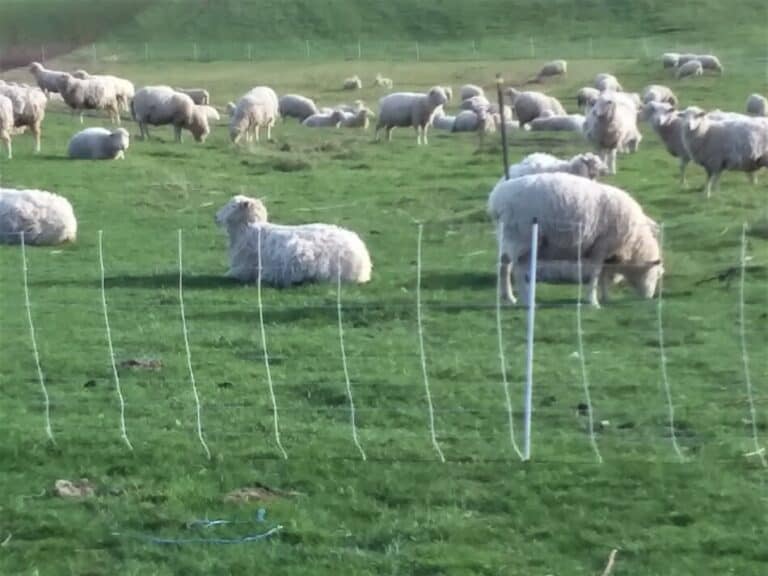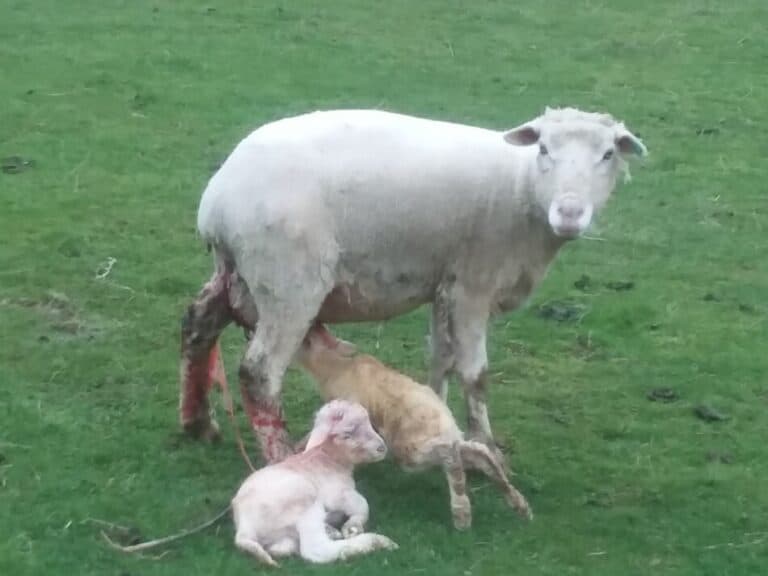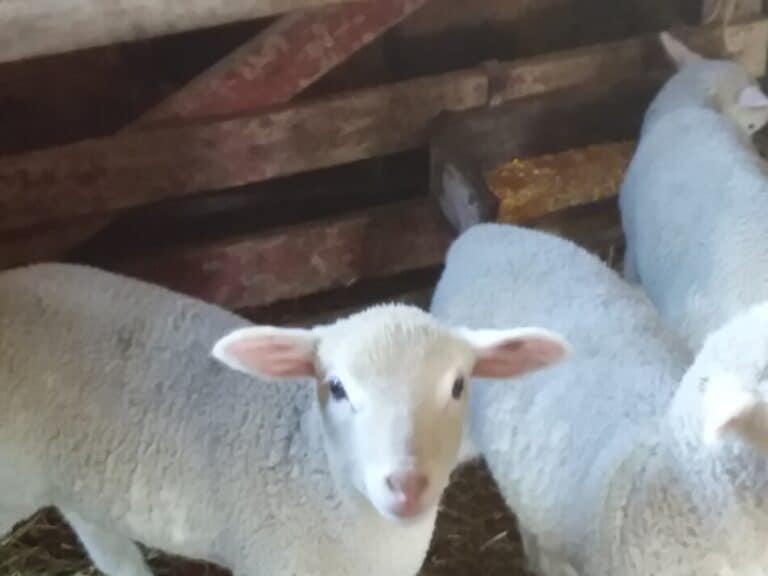8 Ways To Tell When Sheep Are Happy

It can be hard to tell when your sheep are happy, especially when you are new to raising sheep! What are some of the things that you’ll see sheep and lambs doing that show they are happy?
Happy sheep are contentedly grazing
Happy sheep will graze until they are full.
When sheep are happy, they will be contentedly grazing, until they fill up, that is! Sheep are all about eating grass and being chuck full, so they can go lay down and rest.
When you see sheep grazing, you know they feel safe and are finding forages they like to eat in their pasture, which makes them happy.
I know this can sound a bit simplistic to us, but for sheep having plenty to eat and feeling safe where they are grazing are huge positives that help them to have a happy day. It’s just how sheep are wired, full and safe equals happy.
If you are interested, Backyard Sheep is another article I wrote showing an example of how you could set up your yard for grazing by a smaller flock of sheep.
A happy sheep will chew her cud when she is full
Once your sheep are done eating, they will find a nice spot to sit down and start chewing their cud.
Chewing her cud means she will regurgitate a little bolus of grass to rechew it, then swallow this rechewed grass and rechew another bit of grass. This is part of the digestive system of the ruminant that allows her to eat grass for a living!
When you see a sheep chewing her cud, you know that all is right with her world according to her. If she is sick, stressed, or not getting enough to eat she will not be chewing her cud.
For all ruminants, animals like cattle and goats in addition to sheep, chewing their cud is a sign that they are full and their digestive system is working well.
Happy sheep notice you coming into barn or pasture
Happy sheep notice when you show up, they are alert. I don’t mean that they move, toward or away from you, just that they notice.
If they are grazing, when the sheep see you they’ll pop up their heads and watch to see what you are going to do. Maybe they’ll move, maybe they’ll go back to eating, but happy sheep will always notice.
If you go into the pasture and a ewe acts like you are not even there, something is up.
Sheep are hardwired to observe their environment, this is how they avoid predators. A sheep that is oblivious to a big change in the immediate environment, you coming into the pasture, is not behaving normally and needs attended.
Happy sheep are calm
If you look out into the pasture and see that the flock is calm, they are happy. Calm sheep move slowly and casually and are relaxed.
You may hear the occasional calling of a lamb or the ewe to a lamb, but overall, it will be pretty quiet out in the pasture.
The opposite, fast movements, running, flocking up tightly, frantic calling for a lamb, these are all actions from sheep that are not happy, since they are not calm.
When you raise sheep, it’s your job to figure out what is upsetting your sheep when you notice they are not calm and change the situation so they can have a peaceful day.
Is Keeping Sheep Easy? goes over the things you need to know when taking care of your sheep.
Happy sheep are with their flock
Sheep are happy when they are with the flock.
A sheep’s entire life is built around staying with the flock, this is another of those hardwired needs. Being in the flock equals safety and feeling safe is one of the things that makes sheep feel happy.
A sheep that is separated off from the rest of her pals is behaving oddly and in need of a closer look to see what is going on.
Here’s an article on Social Behavior of Sheep, if you want a more scientific look into the details of sheep behavior.
Happy sheep and lambs are doing what peers are doing
Happy sheep and lambs will be with their peers doing whatever their peers are doing at the time. While this sounds a lot like the section above, I put it in because sheep and lambs do different things when they are happy.
Happy lambs tend to run around in this little stampede like group, racing around the pasture a few times just for fun. New lambs are too small for this, but lambs that are a month or so old, can really race around!
Lambs also like to lay in the shade or bask in the sun on cooler days. These are all normal lamb behaviors, some of which the ewes will do as well, some like the stampede are lamb only.
Happy ewes are all about eating and digesting, meaning chewing their cud. A full ewe chewing her cud is a happy ewe.
Happy sheep are evenly spaced, not bunched up
Happy sheep are evenly spaced out, scared or stressed sheep are bunched up.
When sheep are out in the pasture, they are going to be pretty evenly spaced out from each other. They seem to have a distance in mind that is not too close, yet not too far.
If you see sheep bunched up, they are not happy. Chances are they are scared or have just spotted something in the field that they are not sure how to react to so they flock up, just to be sure.
Actually, this brings up another aspect of sheep that you may not have thought of, all that matters is what the sheep thinks, regarding being happy, not what you think.
By this I mean, when your neighbor’s old beagle runs through the flock, he’s not chasing sheep, he’s chasing rabbits! The dog isn’t thinking about those sheep, at all. (Of course, dogs that chase sheep are a different story!)
When you see the sheep flock up or run away, you know it doesn’t matter to the sheep what the beagle is doing, they are still scared.
Really happy sheep bounce, or rabbit hop
When sheep are really feeling great, they’ll rabbit hop or bounce on all four legs rather than walking. Usually, it’s the younger ones, like lambs or younger ewes that do this happiness bounce.
The sheep don’t bounce all of the time, but on days when they feel really good, if you watch, you’ll see them do the four legged bounce.
I notice sheep bouncing on cooler days or mornings, when the air feels invigorating. Apparently the sheep can feel it, too!




